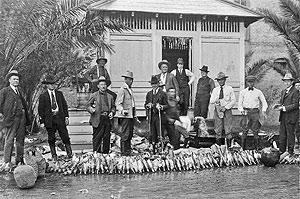 |
 During the Prohibition Era There Were 3 Federal Border Patrols
(08/018/2009) The "New York Times" announced the start of prohibition as the “peaceful death of John Barleycorn,” but bootlegging and smuggling proved the newspaper wrong and made enforcement an ongoing issue. National enforcement was administered by the Office of Federal Prohibition until July 1921 when responsibility was transferred to the Commissioner of Internal Revenue by the incoming Harding administration. On April 1, 1925, Lincoln C. Andrews was appointed Assistant Secretary of the Treasury with supervision over Customs, Coast Guard, and Prohibition. He reorganized prohibition enforcement.U.S. Customs Border PatrolEstablished in 1853; closed down for the first time in 1948; reestablished in 1973, and with the exception of the Customs Patrol Officers (CPO's) of the Tohono O'odham Nation in Arizona, was closed down for the second time in 1991. The greater majority of the former CPO's were retitled Customs Criminal Investigators. The Native American CPO's, today more familiarly known as the Shadow Wolves, are now an important group within today's U.S. Immigration and Customs Enforcement. The "New York Times" announced the start of prohibition as the “peaceful death of John Barleycorn,” but bootlegging and smuggling proved the newspaper wrong and made enforcement an ongoing issue. National enforcement was administered by the Office of Federal Prohibition until July 1921 when responsibility was transferred to the Commissioner of Internal Revenue by the incoming Harding administration. On April 1, 1925, Lincoln C. Andrews was appointed Assistant Secretary of the Treasury with supervision over Customs, Coast Guard, and Prohibition. He reorganized prohibition enforcement.U.S. Customs Border PatrolEstablished in 1853; closed down for the first time in 1948; reestablished in 1973, and with the exception of the Customs Patrol Officers (CPO's) of the Tohono O'odham Nation in Arizona, was closed down for the second time in 1991. The greater majority of the former CPO's were retitled Customs Criminal Investigators. The Native American CPO's, today more familiarly known as the Shadow Wolves, are now an important group within today's U.S. Immigration and Customs Enforcement. |  | click for hi-res
 | | In the back yard of the Custom House in Brownsville, Texas – U.S. Customs Mounted Inspectors empty confiscated liquor during the heyday of Prohibition. |
|
|  |  |
U.S. Immigration Border PatrolEstablished in 1924 in the U.S. Immigration Service; later became the U.S. Border Patrol within the U.S. Immigration and Naturalization Service, and was integrated with the creation of the Department of Homeland Security as the Office of Border Patrol. |  | click for hi-res
 | | 1926, near Tucson, Arizona. Two U.S. Immigration Service Border Patrol Inspectors guard and search liquor smugglers, plus relieve them of the guns. |
| |
Photo Credit: University of Texas at Austin; Smithers Collection |
|
|  |  |
U.S. Prohibition Border PatrolEstablished in 1927 in the newly created Bureau of Prohibition. With the Bureau of Customs and the Coast Guard designated to enforce all narcotics laws, and the Bureau of Prohibition responsible for administering narcotics l laws, the resultant overlapping responsibilities quickly caused confusion and conflict between the three organizations. In January of 1930, the Bureau of Prohibition and its patrol function was dismantled with alcohol taxation responsibilities going to the Treasury Department's Internal Revenue Bureau, and the remaining functions transferred to the Justice Department. |
 |
|  |